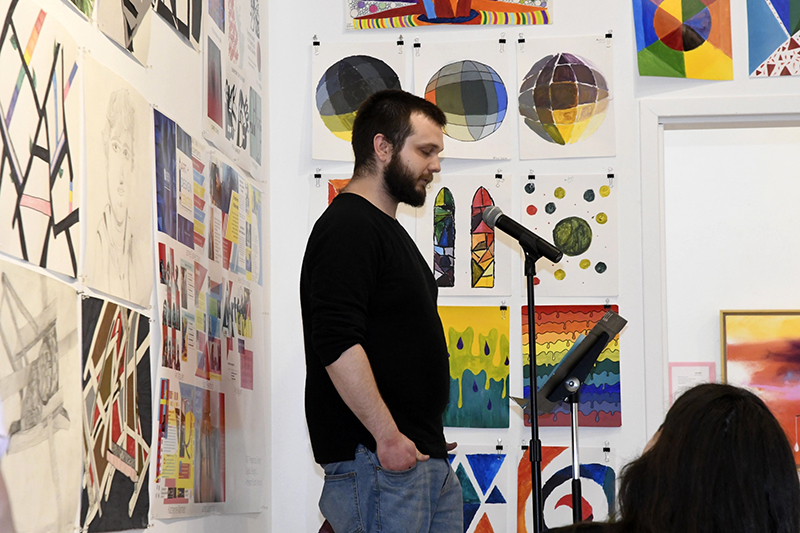Campus Publication Produces Creativity
by Krista Cascio
Whether it’s honing your skills in the dental hygiene program that interests you, or if you want to see your name in print from a journalism course, or anything in between, Cape Cod Community College (4Cs) offers a wide variety of courses that are not only hands-on, but also incredibly rewarding.
One course in particular, titled Producing Magazine of the Arts (ENL170), places students on the publication staff of the 4Cs literary and arts magazine known as Sea Change.
The content of Sea Change includes art and photography, featured beside literature such as fiction, nonfiction and poetry which is submitted by the students, faculty and staff at 4Cs.
Despite a five-year hiatus from the years 2012 to 2017 the magazine has been a campus staple for 51 years since its publication in 1968.
“Students hope that the Sea Change will be a focal point for artists and writers throughout our campus community,” said Rebecca Griffin, current Sea Change faculty adviser. “Its publication gives creative students a voice and a place to share their work.”
The process of constructing a new edition of Sea Change begins with a campaign to launch submissions, before reading and reviewing each one, considering how it would fit within the magazine.
“This process takes time, because the Sea Change receives some 200 submissions and can accept maybe 30 or so,” explained Griffin.
Though any artist or lover of the arts will tell you that there are no true rules in creativity, the thing that makes art appealing is the aesthetic of the piece. Part of reviewing submissions means contemplating the flow of the content when everything’s been put together.
“Every year, students regret being unable to publish work they like, but they need to consider which work fits together,” said Griffin. “And sometimes they may like an individual piece, but it doesn’t match other work that has been submitted—or it doesn’t really fit with the vision they have of the magazine.”
Griffin goes on to express the difficulties that can sometimes be faced in a class like this where students are required to combine ideas to create a single, cohesive product in one semester. She also explained that, “this experience gives students an insight into what it is like to work in publishing with a team, where everyone takes on a different role.”
“In the end,” said Griffin. “All that hard work boils down to something that can be enjoyed and shared with friends and family. The final publication contains a piece of everyone involved.”
And at the end of the semester the magazine hosts an annual reading during the Student Art Show in which Sea Change content creators can read their accepted work to an audience. At this event, physical copies of the art featured inside of the magazine can be seen in person.
“The students really shine at this reading,” Griffin said. “It’s always a happy day for me.”
Sea Change has since become more than just a magazine to the students who participate in its production. In fact, it has sparked its own small creative community right here at 4Cs.
“I’m most excited about former Sea Change students getting together to form a creative writers club on campus,” said Griffin.
New to 4Cs this semester, former Sea Change editors Joe Thorpe and Cassie LeBel have founded the Writers’ Club, of which Griffin serves as the club adviser. According to Griffin, the club “is going strong, with many enthusiastic members.”
For spring semester 2020, students who register for the ENL170 course have the opportunity to join this community by being a part of producing the next edition of Sea Change.
“One very important purpose of Sea Change is to help creative students find each other and learn about one another through collaborating on a shared project,” expressed Griffin.
Caleb Burroughs, who worked on the 2019 edition of Sea Change as Correspondence Editor as well as Poetry Editor, stated that being a part of Sea Change provided him the kind of community he was hoping for.

Photo: Caleb Burroughs. Photo by: Bruce McDaniel
“I got to be around creative people,” said Burroughs. “I made new friends. I was exposed to art and literature made by my peers. Seeing my peers’ creative work was inspiring. It helped me set a new bar for myself as a writer.”
Burroughs conveyed his experience in the class, and why he thinks students with the right motivations will truly thrive in this class.
“There’s not much lecture…” Burroughs said. “You’ll learn how to produce an arts magazine by doing it. It’s a lot of work, but if a career in the arts is what you’re after, you’ll probably find it fun and satisfying.”
Ultimately, Sea Change is about the creativity that people harbor within, and allowing those with that creative drive to shine, whether it be through submitting to the magazine or through being a part of the publication team itself. The principal concept is appreciation for the arts, and by way of that, an appreciation for creativity.
“Students tend to connect with each other [in ENL170] more so than in other classes,” Griffin said. “It’s both a lot of work and a lot of fun. It’s also offers a hands-on, real-world experience collaborating on a creative project.”
Categories: Featured, Around Campus